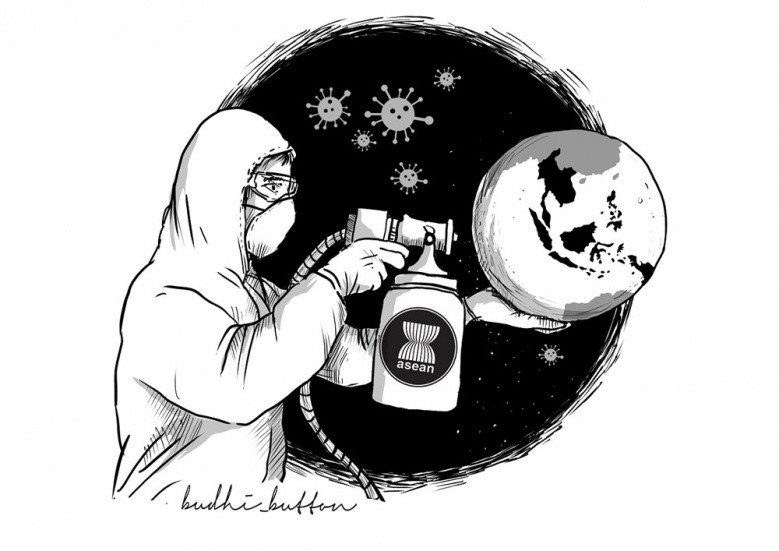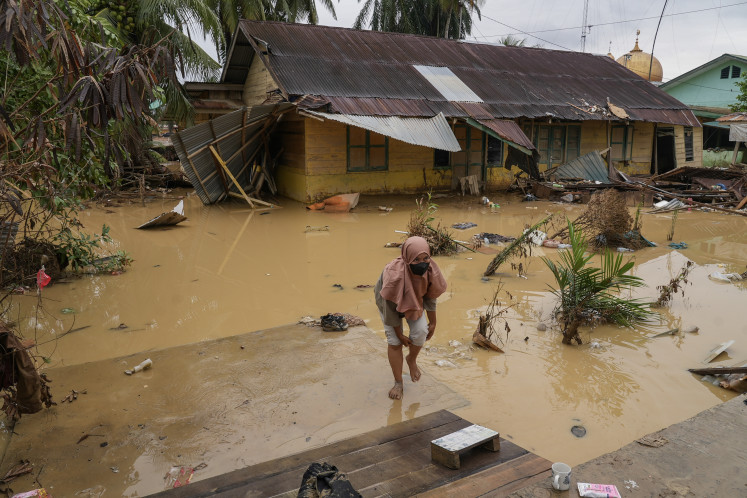Popular Reads
Top Results
Can't find what you're looking for?
View all search resultsPopular Reads
Top Results
Can't find what you're looking for?
View all search resultsRecovering and building back better as a region
The question is then what kind of recovery is envisaged by ASEAN. In my view, ASEAN’s recovery work must provide strategic responses in the following five priority areas.
Change text size
Gift Premium Articles
to Anyone
A
s we enter the third quarter of the year, much has been understood about COVID-19 since it first emerged. Around the world, countries are getting better at managing the spread of the virus, but the battle against rising or resurging cases continues, including in parts of ASEAN. When the pandemic will come to an end remains unknown.
Beyond the human costs, the pandemic has taken a toll on the economy. The growth outlook for the region has been further revised downward, from initially a 1 percent growth at the start of the pandemic, to a 2.7 percent contraction and now a 3.8 percent contraction.
Notwithstanding, there are early signs of recovery where economies have started to reopen, and the latest data has raised some hope that perhaps global trade is not being hit as badly as expected. While recovery is expected by 2021, it is foreseen to be an “L” or a swoosh-shaped rather than a “V” shaped recovery.
Unless concerted efforts are made to address this, we will risk having millions falling back into poverty, seeing a reversal of development progress made over the years and facing permanent productivity and welfare loss.
Despite the shadow of uncertainty, planning for what comes after must start now. Eventually, vaccine and treatment will be found. But once the health crisis is contained, addressing the socioeconomic impact of the pandemic, which will linger long after, becomes an urgent task. Those that are well prepared will have a good head start in the onward march toward recovery.
Obviously, there is no one-size-fits-all approach to recovery efforts. What is clear is for recovery planning to be effective, we must adopt tailored, practical solutions with clear political guidance and buy-in to steer our collective work out of this crisis.
For ASEAN, the first and important step begins with the development of a comprehensive recovery framework, which has already commenced. The ongoing work is being led by the ASEAN Coordinating Council Working Group on Public Health Emergencies, supported by the ASEAN Secretariat. The Working Group is a recently established body with cross-pillar representation and reports to the ASEAN Coordinating Council, the second highest body after the ASEAN Summit. The framework, along with its implementation plan, are expected to be submitted to the leaders at the 37th ASEAN Summit in November.
The question is then what kind of recovery is envisaged by ASEAN. In my view, ASEAN’s recovery work must provide strategic responses in the following five priority areas.
First of all, COVID-19 is a public health crisis. The framework must aim to address key vulnerabilities and disparities in the health systems exposed by the pandemic. A good part of the efforts and resources should therefore be focused on strengthening the capacity of the region’s health systems to collectively and effectively respond to this and future pandemics.
Second, recovery efforts should put the people at its core, focusing on impactful actions that deliver real benefits to safeguard well-being. Time has shown that in times of crises, it is the most vulnerable who are bearing the hardest impact. Among businesses, micro, small, and medium enterprises are most affected, the same for low-income and informal workers.
The ASEAN recovery framework will need to look at enhancing different aspects of human security, focusing on the vulnerable groups. Defined as “people's safety from chronic threats and protection from sudden hurtful disruptions in the patterns of daily life”, human security considerations should cover different aspects of livelihood, from social security, food and nutrition to education, jobs and health.
Third, COVID-19 recovery will, in large part, be an effort to pull economies out of recession. Some businesses may not make it back to business, just as some workers may not be able to make their way back to employment.
The option of relying on external sector will be limited, as economies outside the region, too, are struggling. All these are exacerbated by the uncertainties brought about by geostrategic rivalry as well as the already muted global trade and investment.
There is never a more urgent time for ASEAN to fully realize the potential of its internal market. Removing tariff barriers or formal restrictions is not sufficient. We need to do more to keep the macroeconomy stable and maintain financial liquidity, tackle non-tariff barriers, ramp up trade and investment facilitation, embrace digitalization and dematerialization of trade, to name a few.
There have been recent positive movements from the onboarding of all 10 ASEAN member states on the ASEAN Single Window live environment to the recent operationalization of the ASEAN-Wide Self Certification Scheme, but more is needed, faster and better.
By leveraging on its collective competitiveness, ASEAN can be a stronger player in the broader regional economy. Improving utilization and upgrading of its existing free trade agreements (FTAs) and ensuring the signing and early entry into force of the Regional Economic Comprehensive Partnership (RCEP) should form part of the region’s recovery strategy.
Fourth, and as has been extensively and widely recognized, the COVID-19 pandemic propels digitalization in all aspects of our lives. Digitalization will be the linchpin of the post-pandemic world. It must therefore be embraced as a broad-based strategy across all sectors and in different dimensions, not just in the economy, but also infrastructure, institutions and regulations, processes, the public sector, social sectors like education and health, and for all stakeholders, big and small businesses, rural and urban dwellers, youth and seniors, across genders and so on.
Some sectors or segments of the population will require greater resources and technical support to be adept in digital technologies and to be assured of access to affordable and quality digital infrastructure and technologies. More than ever, cybersecurity, data privacy and trustworthy digital networks have become critical underlying conditions for sustainable digitalization. This is a big undertaking, but is a necessary and urgent element of ASEAN’s COVID-19 recovery.
Lastly, the COVID-19 pandemic has been a wake-up call for the modern society. We should not continue the way we produce, consume, work, transport and travel unchanged. We need to live in harmony with the broader ecosystem. Climate change is no longer a mere threat or danger. It will soon turn into a certain crisis. The effects are already being felt and suffered by many. We need to look after our environment and biodiversity, if not for anything then for humanity’s long-term survival.
ASEAN’s COVID-19 recovery must, therefore, look at strategies to mainstream sustainability considerations into all dimensions of our work, from energy and agriculture to disaster management and financing.
In all these strategies, governments cannot do it alone. COVID-19 recovery efforts are a community-wide endeavor, calling for support from and partnership with all stakeholders, including the business sector, civil societies, development partners and the international community.
Just as important as framing ASEAN’s COVID-19 recovery efforts is having a vision of ASEAN in a post-pandemic world. This conversation alone would be deserving of its own space and should also be informed by the outcomes of the Mid-Term Review of the ASEAN Community Blueprints to look at both contextual and implementation challenges.
But one can expect to see an even greater imperative for ASEAN centrality and unity as the bedrock of collective resilience in the region. The crisis has taught us compassion, and renewed the call for a more equal, inclusive, and sustainable community. It also gives us the opportunity to address the weaknesses in our fundamentals to protect lives and livelihoods of not just those who are affected today, but also to ensure wellbeing of those tomorrow.










